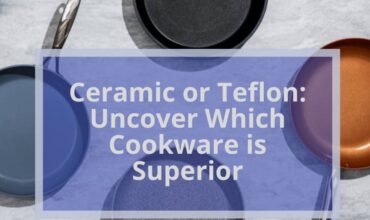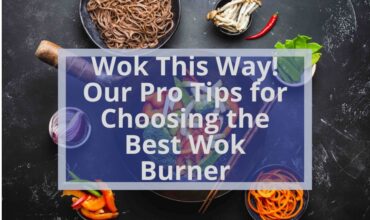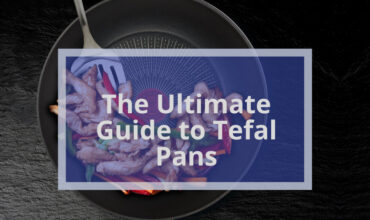What’s the difference between a sauté pan and a skillet? Sauté pans have straight sides and broader bottoms to cook larger batches or wet dishes well. Skillets have sloped sides and are lighter for easy tossing and stirring when stir-frying meats and veggies.
But shape isn’t everything! It would help if you had the full scoop on their similarities and differences to understand when to use each pan. Should you reach for the sauté pan or the skillet for tonight’s dinner? Read on to find out which pan will be the MVP of your kitchen!
Which One Should You Use, A Sauté Pan or A Skillet?
It depends on what you like to cook. Both pans have good uses. We can help you pick the right pan for each recipe. But first, let’s figure out The Similarities and Differences Between Sauté Pans and Skillets.
The Similarities and Differences Between Sauté Pans and Skillets.
1. Shape And Size
The shape and size of a sauté pan and skillet are different. A sauté pan has taller sides and a broader base, while a skillet has slanted sides and is smaller and shallower.
The sauté pan’s design allows for more space and a larger cooking surface, ideal for cooking larger quantities of food or dishes that require a significant amount of liquid.
On the other hand, the skillet’s slanted sides and smaller size make it perfect for quick cooking techniques like stir-frying and sautéing vegetables or chopped meat.
The sauté pan’s straight sides prevent liquid from splashing out, while the skillet’s sloping sides aid in evaporation for searing and reducing sauces.
Both pans can be used interchangeably and have their unique advantages.
2. Materials
Stainless steel and cast iron are standard for sauté pans and skillets. These materials provide durability and excellent heat distribution, ensuring even cooking.
Stainless steel pans are known for their non-reactive surface, making them ideal for cooking acidic ingredients.
On the other hand, cast iron pans retain heat well and are perfect for dishes that require long, slow cooking.
Both materials are versatile and can be used on various heat sources, including stovetops and ovens.
3. Lid
When choosing between a sauté pan and a skillet, it’s essential to consider whether or not a lid is necessary for your cooking needs.
A sauté pan typically has a tight-fitting lid, while skillets usually do not.
If you frequently cook dishes that require simmering or braising, a sauté pan with a lid would be the better choice. The lid helps to trap heat and moisture, allowing for even cooking and flavour infusion.
On the other hand, if you primarily use your pan for quick-cooking techniques like sautéing or stir-frying, a skillet without a lid may be more suitable.
4. Uses
If you’re looking for a pan that can handle a variety of cooking techniques, both a sauté pan and a skillet are versatile options.
A sauté pan is ideal for dishes that require a significant amount of liquid, such as braising or shallow-frying. Its straight sides allow for a higher volume of liquid and prevent splashing while moving the pan. The larger cooking surface of a sauté pan is advantageous for cooking larger quantities of food.
On the other hand, a skillet is great for dishes that require constant stirring, like sautéing vegetables or chopped meat. Its sloping sides make it easier to shake and stir for even cooking.
Both pans can be used interchangeably and are constructed from the same metals.
5. Price
Considering your budget, you’ll find that frypans are generally less expensive than sauté pans due to their smaller size and sometimes lighter material. While sauté pans offer versatility and a larger cooking surface, frypans are a more affordable option for those on a tight budget.
Despite the price difference, both options can yield similar results, so the choice ultimately depends on your cooking preferences and needs.
6. Durability
Now that we’ve discussed the price of sauté pans and skillets, let’s move on to another essential factor to consider when choosing between the two: durability.
Regarding durability, both sauté pans and skillets are designed to withstand high heat and everyday use in the kitchen. However, there are some differences to keep in mind.
Sauté pans are typically made with thicker materials, such as stainless steel or cast iron, which makes them more durable and long-lasting. They can handle heavy use and are less prone to warping or denting. The straight sides of sauté pans also provide additional structural support, making them more damage-resistant.
Skillets, however, can vary in terms of durability depending on the material they are made of. Cast iron skillets are known for their exceptional durability and can last for generations with proper care. Non-stick skillets, while convenient, may not be as durable and require more careful handling to prevent scratching or peeling of the non-stick coating.
In summary, sauté pans and skillets are durable options for your kitchen. Sauté pans, with their thicker construction and straight sides, tend to be slightly more durable in the long run. However, the durability of a skillet can also depend on the material it is made of.
7. Heat Distribution
When choosing between a sauté pan and a skillet, you’ll notice that the heat distribution is an essential factor to consider. Sauté pans and skillets distribute heat differently due to their varying designs.
Sauté pans have straight sides and a broader base, which allows for slower but more even heat distribution. This makes them ideal for dishes that require longer cooking times or a significant amount of liquid.
On the other hand, skillets have sloped sides that promote quicker heat distribution and are excellent for searing and fast cooking techniques.
Understanding the heat distribution capabilities of each pan will help you determine which one is best suited for your specific cooking needs.
8. Ease Of Cleaning
To make cleaning more manageable, you’ll appreciate that a sauté pan and a skillet have non-stick options. Non-stick coatings prevent food from sticking to the surface, making it effortless to clean up after cooking. Whether you choose a sauté pan or a skillet, the non-stick feature will save you time and effort in the kitchen.
Also read: “Are Blue Diamond Pans Worth Their Weight in Diamonds?
Different types of sauté pans and skillets
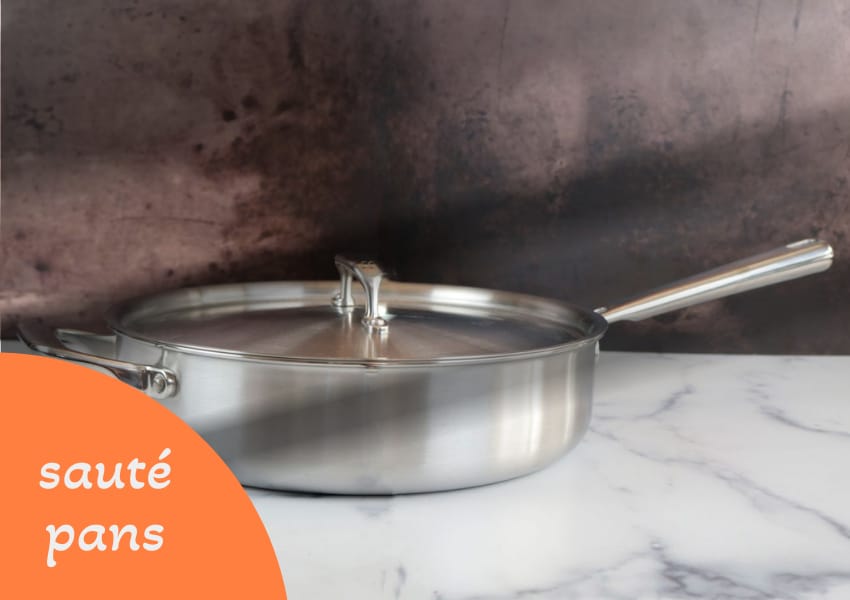
Various sauté pans and skillets are available to suit different cooking needs. Regarding sauté pans, you can find options like stainless steel, non-stick, and cast iron. Each type has its advantages and disadvantages.
Stainless steel sauté pans are durable, non-reactive, and great for browning food. Non-stick sauté pans make cooking and cleaning a breeze but may not be as durable. Cast iron sauté pans provide excellent heat retention and are ideal for high-heat cooking.
Skillets also come in stainless steel, non-stick, and cast iron. They are versatile and can be used for various cooking techniques.
Also read: Best Egg Frying Pan
How To Choose The Right Sauté Pan Or Skillet For Your Needs
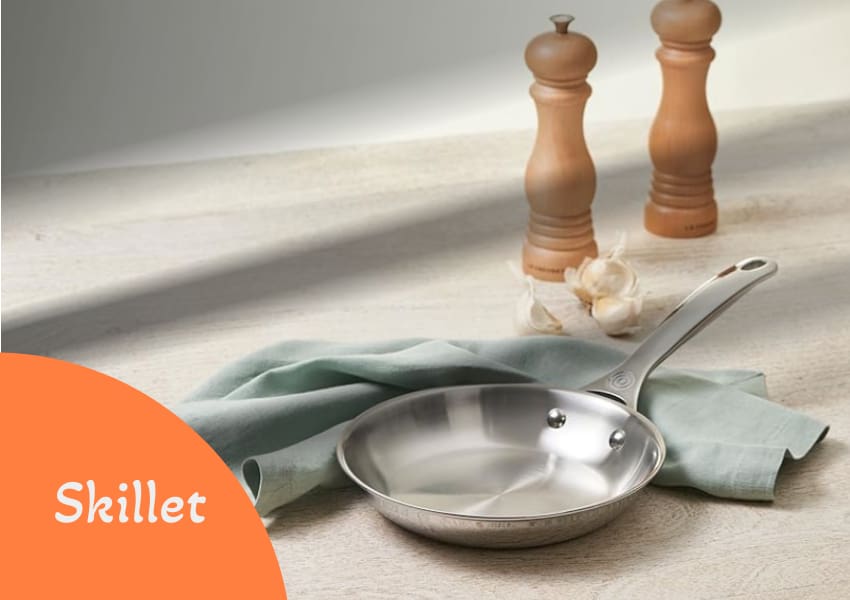
Now that you understand the different types of sauté pans and skillets available, it’s time to choose the right one for your needs. When selecting a sauté pan or skillet, there are a few factors to consider.
First, think about the type of cooking you do most often. Do you frequently cook dishes requiring a lot of liquid, like stews or braises? If so, a sauté pan with its larger surface area and straight sides would be an ideal choice.
On the other hand, if you prefer quick stir-fries or searing meats, a skillet with slanted sides and lighter weight may be more suitable.
Next, think about your personal preferences and cooking style. Do you prefer a pan with a more extended handle for easy flipping and tossing, like a frypan? Or do you like the stability and control provided by a sauté pan’s two handles? Consider the size and weight of the pan as well, as this can impact its usability for different cooking techniques.
Choosing between a sauté pan and a skillet depends on your needs and preferences. Experiment with both and see which one works best for you. Remember, the most important thing is to enjoy cooking and creating delicious meals that bring you joy and satisfaction.
How To Care For Your Sauté Pan Or Skillet?
When caring for your sauté pan or skillet, cleaning it thoroughly after each use is necessary to maintain its quality and prevent any residue from building up.
To clean your pan, start by letting it cool down completely. Then, use warm water and mild dish soap to wash the pan, removing any stuck-on food particles.
Avoid using abrasive scrubbers or harsh cleaning chemicals, as they can damage the pan’s surface. After washing, dry the pan thoroughly to prevent any moisture from causing rust or corrosion.
It’s also a good idea to season your pan regularly to maintain its non-stick properties. By taking proper care of your sauté pan or skillet, you can ensure its longevity and enjoy cooking with it for years.
Also read: Best Pots and Pans for Gas Stove
How To Troubleshoot Common Problems With Sauté Pans And Skillets
Sauté pans and skillets are workhorse pans. But, like any tool, problems pop up. Here is my guide to solving the most common issues.
Food Sticking – Let oil fully heat before adding food. Overcrowding causes food to steam and stick. Give room for sautéing. Clean stuck-on bits with hot water, not cold.
Burned Food – Lower heat and stir often to prevent scorching. Deglaze with broth or wine to loosen any burnt bits. Add acid like lemon to counter the bitterness.
Warping – Never put a hot pan in cold water or expose it to significant temperature changes. This can warp the pan. Cool pans gradually before washing.
Rust Spots – Dry pans entirely after washing to avoid rust. Remove spots gently with baking soda and a soft sponge. Avoid abrasives that can damage the pan.
Pitted Surface – Don’t use metal utensils or scour pads in pans. This can scratch and pit the surface over time. Use wood or silicone utensils.
With some care and maintenance, sauté pans and skillets will give years of delicious cooking. Follow these tips to keep your pans in top shape!
Here are some suggested FAQs to add regarding sauté pans vs skillets, focusing on points not already covered in the article:
FAQs
What types of handles do sauté pans and skillets typically have?
Sauté pans often have two loop or helper handles, while skillets more commonly have a single long handle. The sauté pan’s two handles provide more control and balance when tossing foods. The skillet’s longer handle helps with leverage when flipping or moving foods in the pan.
Can you use sauté pans or skillets on induction cooktops?
You can use either pan on an induction cooktop if it is made of a ferromagnetic material like cast iron or magnetic stainless steel. Avoid non-magnetic metals like aluminium or copper. Check the pan specs to confirm induction suitability.
How do you know what size sauté pan or skillet to use?
For everyday cooking, a 10 or 12-inch skillet or sauté pan is versatile for most needs. Choose a smaller 8-inch for quick sautéing small batches. Go larger, like 14 inches, for big jobs like paella or deep frying. Consider your stove’s burner size too.
Should the pan size match the burner size?
Using a pan that matches or is slightly larger than your cooktop burner is best. Too small, and heat won’t distribute well. Overhang the burner too much, and stability suffers. But a little overhang is okay.
What are the best materials for sauté pans and skillets?
Stainless steel, cast iron, carbon steel, and aluminium work well. Each has pros and cons. Stainless has poor heat conductivity but is durable. Cast iron retains heat beautifully but is heavy. Carbon steel heats evenly but requires seasoning.
Conclusion
· Sauté Pans
- Sauté pans have straight sides to fit more food.
- Their broad, flat bottoms cook big batches well.
- They often have lids to trap steam when braising.
- Sauté pans excel at cooking large amounts of wet dishes like stews. Their tall sides prevent splashing.
- It distributes heat slowly but evenly, which is great for long braises.
· Skillets
- Skillets have sloped sides that make tossing and stirring easy. Their shape is excellent for stir-frying.
- They usually don’t have lids since they’re used for quick sautéing.
- A Skillet would be perfect for fast sautéing and stir-frying veggies and meats. It’s shape makes tossing and flipping easy.
- Skillets heat up fast, ideal for quick searing.
- Both pans come in stainless steel and cast iron. These spread heat evenly for good cooking.
- Stainless steel won’t react with acidic foods. Cast iron keeps heat very well for long cooking.
- Skillets tend to cost less than sauté pans. Their small size uses less material. But sauté pans give more room to cook bigger meals.
- Sauté pans are very durable due to their thick steel and straight sides. Cast iron skillets also last a very long time with proper care. Treat your pans nicely, and they’ll last for years.
- Get a pan with a non-stick coating to make cleanup a breeze. It prevents food from sticking.
- Think about how you cook most when choosing a pan. Pick the shape and size that fits your needs. Then, get cooking yummy family meals!
